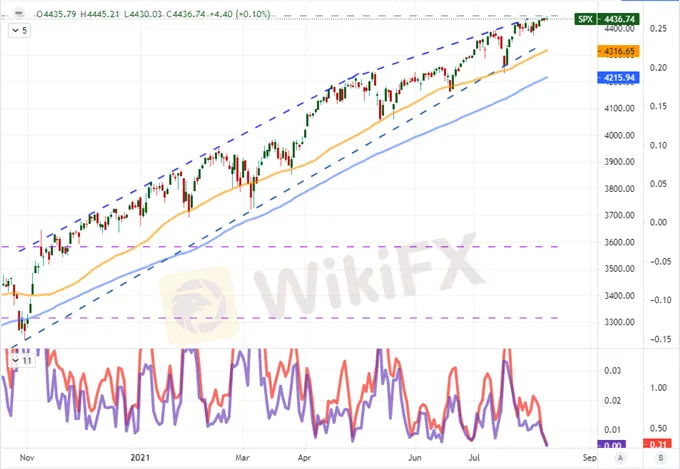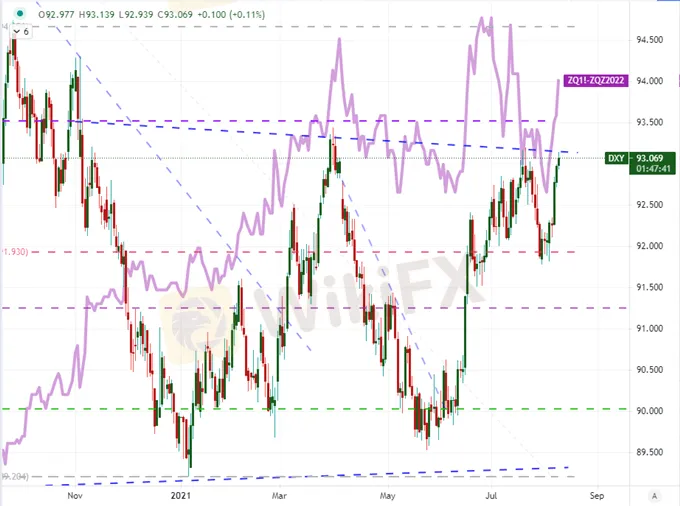简体中文
繁體中文
English
Pусский
日本語
ภาษาไทย
Tiếng Việt
Bahasa Indonesia
Español
हिन्दी
Filippiiniläinen
Français
Deutsch
Português
Türkçe
한국어
العربية
EURUSD Outlook: Will Upcoming CPI Override Market Calm, Charge Breakdown?
Abstract:S&P 500, GOLD, EURUSD AND DOLLAR TALKING POINTS
Golds Monday flash crash seems to be firmly behind us with the major exception to market calm returning to very limited volume and daily range
Despite the difficulty across markets to produce serious breakouts – much less trends – the positioning of EURUSD at 1.1700 is drawing a lot of speculative interest
While the US CPI release is due ahead and Fed rate expectations are climbing, a break is still a high threshold, but views differ on the next move

I am like many traders in that I look for some degree of volatility and market movement to present the kind of opportunities that suit my approach. Generally, I am a medium-term swing trader with a time frame on setups that usually spans 2 days to 2 weeks. However, productive moves over that time frame usually entails larger swings in price action than what we have seen these past months. When faced with difficult conditions, desire can start to override rational analysis; and impractical expectations start to arise. The S&P 500‘s inability to make a productive drive despite its staging at record highs is a little easier to appreciate given how long it has struggled for progress. Over the past three days, the benchmark’s range and volatility through ATR (both as a ratio of spot) have dropped back to the lowest levels since the December holiday period of 2019.
Chart of the S&P 500 SPY with 50 and 100-Day SMAs with 3-Day ATR and Range (Daily)

It is understandable against this backdrop of hope for the eventual change in these market conditions that speculators were reading into the recent collapse in gold a seismic shift – for this particular asset if not the entire market. Between the Friday‘s NFPs-induced tumble and Monday’s ‘flash crash’, the metal dropped as much as 7 percent in the span of less than 48 hours. The break through 1,760 trendline support would only further the expectations, and Monday‘s sharp reversal wouldn’t dissuade conviction as volatility is the target and not trend. However, the outlier theory is difficult to hold out for through this past session‘s activity. Through the moderation of price, volume barely budged, the bounce added 1,675 support as a backdrop and Tuesday’s trading range moved right back to the average scale we have averaged over the previous months. The volatility was good while it lasted, but I am maintaining my dubiety.
Chart of the Active Gold Futures Contract, Volume and 1-Day ATR (Daily)

It is important not to let specific examples stand in for the context of the broader market. That is a recipe for falling back into the trap of assuming easy and convenient exceptions to the rule. Broadly speaking, the markets are running through seasonally-exaggerated doldrums, compounding the kind of grind that seems to occur when cycles move into the latter stage of a mature bull. Therefore, I will evaluate situations where the potential seems to be an exceptional break or trend with greater scrutiny than situations that are oriented towards congestion – either ranges or very measured trends.
Chart of S&P 500 Seasonal Performance, Volume and VIX

I started with my general perspective of market conditions before I addressed yet another situation where the technicals and fundamentals could be interpreted as loaded in different environments. EURUSD has extended an impressive 8 consecutive trading day slide to match the longest drop for the benchmark pair since December 12, 2017 – and there are only a handful of comparable bear moves over the past decade. Despite the consistency, the pace leaves much to be desired, but the presence of the 1.1700 figure is generating technical interest while the presence of Wednesdays US CPI release raises the potential of an acute catalyst. In this scenario, a range move would be more productive, but not by much.
Chart of EURUSD with 20 and 100-Day Moving Averages with Consecutive Daily Moves (Daily)

Now, while I do believe the market is predisposed to hold to a controlled tempo whether EURUSD makes a next move higher or lower, there is potential to stir some volatility – even briefly. While there is plenty of event risk on tap, it seems most market participants have come to terms with the reality that most catalysts are not going to produce significant movement. Yet, where anticipation may build beyond the skepticism a little more emphatically is with the upcoming US inflation report. The 12:30 GMT release of the consumer price index report for the month of July represents a black-and-white update on Fed policy potential from the market‘s favorite inflation figure. Momentum has built up from the NFPs beat on Friday, Bostic’s overtly hawkish remarks on Monday and even Chicago Fed President Evans comments on Tuesday.
This past session, Evans, who I would consider one of the FOMC‘s most dovish members, noted that he could support a taper after a few more months of robust job reports. The scale of expectations from this group generally supports a reduction in asset purchases (which precedes a hike) in the coming months. The particulars of the vote count and data can make that a September/October event or November/December occurrence. Given how far the Fed’s influence stretches through the global financial system, the CPI data could readily be read into.
Chart of DXY Dollar Index Overlaid with Fed Implied Hikes Dec 2022 (Daily)



Disclaimer:
The views in this article only represent the author's personal views, and do not constitute investment advice on this platform. This platform does not guarantee the accuracy, completeness and timeliness of the information in the article, and will not be liable for any loss caused by the use of or reliance on the information in the article.
Read more

Weekly Fundamental Gold Price Forecast: Hawkish Central Banks a Hurdle
WEEKLY FUNDAMENTAL GOLD PRICE FORECAST: NEUTRAL

Gold Prices at Risk, Eyeing the Fed’s Key Inflation Gauge. Will XAU/USD Clear Support?
GOLD, XAU/USD, TREASURY YIELDS, CORE PCE, TECHNICAL ANALYSIS - TALKING POINTS:

British Pound (GBP) Price Outlook: EUR/GBP Downside Risk as ECB Meets
EUR/GBP PRICE, NEWS AND ANALYSIS:

Dollar Up, Yen Down as Investors Focus on Central Bank Policy Decisions
The dollar was up on Thursday morning in Asia, with the yen and euro on a downward trend ahead of central bank policy decisions in Japan and Europe.
WikiFX Broker
Latest News
Germany's Election: Immigration, Economy & Political Tensions Take Centre Stage
WikiFX Review: Is IVY Markets Reliable?
IG 2025 Most Comprehensive Review
ED Exposed US Warned Crypto Scam ”Bit Connect”
Top Profitable Forex Trading Strategies for New Traders
EXNESS 2025 Most Comprehensive Review
Currency Calculator






